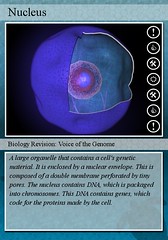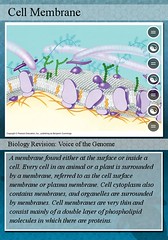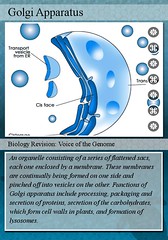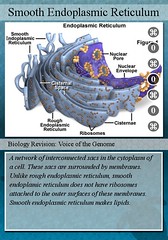chloroplast: makes food for plant cells, photosynthesis
mitochondria:produces energy the cell needs to carry out its functions; release energy
vacuole: stores food, water, and waste
lysosome: found mainly in animal cells, digests old cell parts
endoplasmic reticulum: carries proteins and other materials from one part of the cell to the other
cytoplasm: gel -like fluid where the organelles are found
nucleolus: makes ribosomes, center of the nucleus
ribosome: makes proteins
cell membrane:controls what comes into and out of the cell, found in plants and animals
nucleus: controls cell activity
cell wall: protection and support for plant, not animal cells; rigid outer layer
| 2028476573 | cell wall | protection and support for plant |  | 0 |
| 2028476574 | nucleus | controls cell activity |  | 1 |
| 2028476575 | cell membrane | A cell structure that controls which substances can enter or leave the cell. found in plants and animals |  | 2 |
| 2028476576 | ribosome | protein synthesis (making proteins) |  | 3 |
| 2028476577 | Robert Hooke | mid 1600's first person to observe cells by observing cork under a microscope | 4 | |
| 2028476578 | cytoplasm | jelly like, cushion organelles, contain dissolved material |  | 5 |
| 2028476579 | vacuole | stores food, water, and waste *(bigger in plants to store water) |  | 6 |
| 2028476580 | mitochondria | produces the energy a cell needs to carry out its functions |  | 7 |
| 2028476581 | chloroplast | captures energy from sunlight and uses it to makes food for plant cells, photosynthesis |  | 8 |
| 2028476582 | cell theory | 1. cells are the smallest unit of life 2. all organisms are made up of one or more cells 3. all new cell come from preexisting cells | 9 | |
| 2028476583 | organelles | *specialize structures found inside cells *each carries out a specific life function | 10 | |
| 2028476584 | chromosomes | make up strands of DNA |  | 11 |
| 2028476585 | organism | any living thing (i.e.: plants, animals, fungus, bacteria, protist) | 12 | |
| 2028476586 | cell | Basic unit of life | 13 | |
| 2028476587 | prokaryotic | An organism whose cells do not have an enclosed nucleus, such as bacteria. |  | 14 |
| 2028476588 | eukaryotic | Cell with a nucleus (surrounded by its own membrane) and other internal organelles. |  | 15 |
| 2028476596 | golgi body | A structure in a cell that receives proteins and other newly formed materials from the endoplasmic reticulum, packages them, and distributes them to other parts of the cell. |  | 16 |
| 2028476597 | endoplasmic reticulum | A system of membranes that is found in a cell's cytoplasm and that assists in the production, processing, and transport of proteins and in the production of lipids |  | 17 |
| 2028476598 | lysosome | An organelle containing digestive enzymes |  | 18 |
| 2028476599 | centriole | Aid in cellular division | 19 | |
| 2028476602 | concentration | A measurement of how much solute exists within a certain volume of solvent | 20 | |
| 2028476604 | plasma membrane | A selectively-permeable phospholipid bilayer forming the boundary of the cells | 21 | |
| 2028476605 | nucleolus | A specialized structure in the nucleus, formed from various chromosomes and active in the synthesis of ribosomes | 22 | |
| 2028476606 | cell differentiation/speciallisation | The process by which a cell becomes specialized for a specific structure or function | 23 | |
| 2028568373 | Matthais Schleiden | 1838- German botanist, *one of the three fathers of cell theory*, said plants are composed of cells. | 24 | |
| 2028570242 | Theodor Schwann | 1839- German zoologist, *one of the three fathers of cell theory*, created the word metabolism, said animals are composed of cells. | 25 | |
| 2028574084 | Rudolph Virchow | 1855- German physician and professor, *one of the three fathers of cell theory*, stole the idea that animals are made up of cells. | 26 | |
| 2028578974 | Antony Van Leevwenhoek | 1643- Dutch microscope maker and merchant, observed and described LIVING microscopic (and unicellular) organisms from a pond | 27 | |
| 2028622243 | Volume | ________ increases more rapidly than the surface area. For example, as a cell increases in size its' surface area: ________ ratio decreases. | 28 | |
| 2028625310 | Material | The size of a cell is limited by its' need to exchange ________ with its' environment. | 29 | |
| 2028627573 | Volume of ratio | The ______ __ _____ of a cell determines its' rate of metabolism | 30 | |
| 2028629364 | Surface area | The ______ _____ of a cell determines the rate of exchange of material. | 31 | |
| 2028631294 | large | If a cell becomes too ______, the distance that materials need to diffuse becomes too _______ and its' surface area/ volume of ratio is too small to allow necessary exchange. | 32 | |
| 2028634382 | Multicellular Organisms | __________ _________ need to be flat in shape or have specialised exchange and transport systems to ensure all cells receive the materials they need. | 33 | |
| 2028651499 | Direct relationships | two variables increase or decrease together | 34 | |
| 2028654335 | Inverse relationship | one variable increases and the other variable decreases | 35 |

